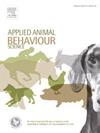How can the stork bring the baby? An evaluation of captive saddle-billed stork reproductive activity and influences of husbandry practices
IF 2.2
2区 农林科学
Q1 AGRICULTURE, DAIRY & ANIMAL SCIENCE
引用次数: 0
Abstract
Husbandry surveys can be useful evidence gathering exercises that enable the formulation, and implementation, of better practice care for species in zoos. Where ecological or behavioural needs of a species can be hard to replicate, or when they experience limited successful reproduction, husbandry surveys can illuminate key elements of good practice from across facilities to meet these challenges and support the development and management of sustainable populations. The saddle-billed stork (Ephippiorhynchus senegalensis) is one example of a challenging species to maintain under human care, with limited successful reported breeding (egg laying, chick rearing and fledging of young). Therefore, research aimed to survey holders of this stork to identify factors influencing reproductive success across AZA and EAZA regions. We found that wild-caught pairs produced significantly more clutches than captive-bred pairs, while flight restriction appeared to negatively impact fertility rates. All successfully breeding pairs exhibited courtship behaviours, though these behaviours alone did not guarantee reproductive success. Whilst a single nesting platform appeared more effective than multiple or no platforms in encouraging nesting, no single demographic, environmental, or husbandry factor significantly predicted egg-laying success. This suggests that successful reproduction depends on complex interactions between multiple variables. Our findings highlight the importance of providing appropriate environmental conditions that support natural behaviours and emphasise the need for a holistic approach to exhibit design for successful breeding of this species in zoological collections. We recommend further research into the ecology of the species itself, especially mate choice and pair bonding mechanisms, to further evaluate variability in zoo-housed stork reproductive efforts.
鹳怎么能把婴儿带来呢?圈养马嘴鹳繁殖活动及其饲养方式影响的评价
畜牧业调查可以是有用的证据收集练习,能够制定和实施更好的动物园物种实践护理。当一个物种的生态或行为需求可能难以复制,或者当它们经历了有限的成功繁殖时,畜牧业调查可以从各个设施中阐明良好做法的关键要素,以应对这些挑战,并支持可持续种群的发展和管理。鞍嘴鹳(Ephippiorhynchus senegalensis)是一个具有挑战性的物种之一,在人类的照料下维持,成功的繁殖(产卵,饲养小鸡和幼鸟)报道有限。因此,研究旨在调查这种鹳的持有者,以确定影响繁殖成功的因素在AZA和EAZA地区。我们发现,野生捕获的成对产卵明显多于人工饲养的成对,而飞行限制似乎对生育率产生了负面影响。所有成功繁殖的配偶都表现出求偶行为,尽管这些行为本身并不能保证繁殖成功。虽然单个筑巢平台在鼓励产卵方面比多个平台或没有平台更有效,但没有单一的人口、环境或饲养因素能显著预测产卵成功率。这表明,成功的繁殖取决于多个变量之间复杂的相互作用。我们的研究结果强调了提供适当的环境条件以支持自然行为的重要性,并强调了在动物收藏中成功繁殖该物种的整体展示设计的必要性。我们建议进一步研究物种本身的生态学,特别是配偶选择和配对机制,以进一步评估动物园饲养的鹳繁殖努力的变异性。
本文章由计算机程序翻译,如有差异,请以英文原文为准。
求助全文
约1分钟内获得全文
求助全文
来源期刊

Applied Animal Behaviour Science
农林科学-行为科学
CiteScore
4.40
自引率
21.70%
发文量
191
审稿时长
18.1 weeks
期刊介绍:
This journal publishes relevant information on the behaviour of domesticated and utilized animals.
Topics covered include:
-Behaviour of farm, zoo and laboratory animals in relation to animal management and welfare
-Behaviour of companion animals in relation to behavioural problems, for example, in relation to the training of dogs for different purposes, in relation to behavioural problems
-Studies of the behaviour of wild animals when these studies are relevant from an applied perspective, for example in relation to wildlife management, pest management or nature conservation
-Methodological studies within relevant fields
The principal subjects are farm, companion and laboratory animals, including, of course, poultry. The journal also deals with the following animal subjects:
-Those involved in any farming system, e.g. deer, rabbits and fur-bearing animals
-Those in ANY form of confinement, e.g. zoos, safari parks and other forms of display
-Feral animals, and any animal species which impinge on farming operations, e.g. as causes of loss or damage
-Species used for hunting, recreation etc. may also be considered as acceptable subjects in some instances
-Laboratory animals, if the material relates to their behavioural requirements
 求助内容:
求助内容: 应助结果提醒方式:
应助结果提醒方式:


